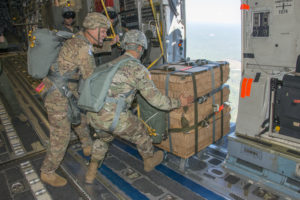
By Mr. James (J.C.) Cochran, Military Test Plans Analyst, Airborne and Special Operations Test Directorate, U.S. Army Operational Test Command Public Affairs
FORT BRAGG, North Carolina — 82nd Airborne Division troopers here are wrapping up testing of the Caster Assisted A-Series Delivery System (CAADS), which involves delivering mission essential supplies and munitions to ground troops.
Soldiers from Company A, 2nd Battalion, 325th Airborne Infantry Regiment, 2nd Brigade Combat Team teamed up with subject matter experts from the United States Army Advanced Airborne School (USAAS).
With the Fort Bragg-based U.S. Army Operational Test Command’s (USAOTC) Airborne and Special Operations Test Directorate (ABNSOTD), they successfully rigged, dropped, and recovered the CAADS door bundles during operational testing on Sicily Drop Zone.
The 82nd Airborne Division is part of the XVIII Airborne Corps, and is the Army’s most strategically mobile division.
82nd Airborne Division Commander, Maj. Gen. Erik Kurilla, said, “The 82nd Airborne Division is the elite Airborne infantry division of the United States Army, specializing in parachute assault operations into denied areas.”
Kurilla wants to be able to deploy three CAADS door bundles per paratroop door. Bundles can weigh up to 500 pounds of cargo and be airdropped from a variety of Department of Defense (DoD) transport aircraft to support the Global Response Force.
The current door bundle limit without CAADS is two bundles per door per pass.
Currently, there is no standardized aerial delivery system in the Department of Defense (DoD) inventory that employs the dolly-assisted method, but other countries like France employ a similar system.
CAADS is a platform built of plywood, a brake, and six caster wheels which allow the door bundle to roll across the aircraft floor, speeding airdrop deployment.
Testing demonstrated safe deployment of door bundles using CAADS to improve the ability of Soldiers deploying the bundles while reducing exit time. The increased speed allows for additional bundles per pass.
The efficiency of the CAADS concept provides the capability of exiting more door bundles per pass, per aircraft — all increasing the amount of supplies on the ground to the paratroopers during their critical 12 hour initial entry phase.
Sgt. 1st Class Miguel A. Amadis of Company A, 2nd Battalion, 325th Airborne Infantry Regiment, 2nd Brigade Combat Team said, “I like the CAADS a lot. It was easy to push, easy to set up at the door, and it will be very useful for the upcoming missions.”
One Airborne unit commander said he liked CAADS’ simplistic design and concept, which can seriously lessen the physical wear and tear on the average paratrooper.
“The castor’s one free axle made the rotation into the door easy, but still kept two axles locked, which maintained control as the container exited the door and entered the slip stream,” said Capt. Matthew P. Carstensen, Commander, Headquarters and Headquarters Company, 2nd Battalion, 505th Parachute Infantry Regiment, 3rd Brigade Combat Team.
“I felt that the concern of jarring the container in the doorway was safely mitigated by those locked axles,” he added. “Looking at future application, a container of this size and capacity can significantly increase the combat power and lethality delivered onto a hostile drop zone on the first pass.”
According to Sgt. 1st Class Martin L. Ross, ABNSOTD Test NCO, operational testing is OTC’s opportunity to contribute to Army readiness.
“Anything less compromises the Army’s ability to provide the forces that fight and win the Nation’s wars,” he said.
“Operational testing is about Soldiers,” said Col. Bradley F. Mock, Director of the ABNSOTD. “It is about making sure that the systems developed are effective in a Soldier’s hands and suitable for the environments in which Soldiers train and fight. Operational testing is OTCs opportunity to contribute to readiness; anything less compromises the Army’s ability to provide the forces that fight and win the Nation’s wars.”
The ABNSOTD Test Division chief explained how test units incorporate systems under test into their actual missions and training requirements.
“Leaders of units involved in testing have the first look at new systems, which may also drive changes to operations and doctrine,” said Lt. Col. Gregory Oquendo. “Tests are unit-led, which translates into coordinated control under realistic operational environment scenarios.”
Other tests underway at ABNSOTD include the Advanced Medium Mobile Power Sources (AMMPS) 30K generator which will replace the relatively short-lived TQG (Tactical Quiet Generator) program and airdrop certification of the Light Armored Vehicle (LAV-25A2) Mobile Protective Firepower (MPF). Highly-instrumented test drops by Airborne and Special Operations Test Directorate (ABNSOTD) will help test overall airdrop survivability of the vehicles.
~~
About the U.S. Army Operational Test Command:
USAOTC is based at West Fort Hood, Texas, and its mission is about ensuring that systems developed are effective in a Soldier’s hands and suitable for the environments in which Soldiers train and fight. Test units and their Soldiers provide feedback, by offering input to improve upon existing and future systems with which Soldiers will ultimately use to train and fight.
The Fort Bragg, North Carolina-based ABNSOTD plans, executes, and reports on operational tests and field experiments of Airborne and Special Operations Forces equipment, procedures, aerial delivery and air transportation systems in order to provide key operational data for the continued development and fielding of doctrine, systems or equipment to the Warfighter.
